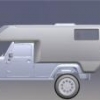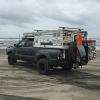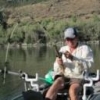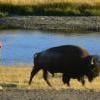I used to be more concerned with weight savings than I am now, mostly because I realize the vehicle doesn't care if there is another few hundred pounds if properly placed, and in some cases it is an advantage (traction). If you're in Colorado you're going to have different needs at different times of the year. Another consideration is what you'll have to carry either way.
You state you may not move for seven days. Seven days of water for two people is roughly 10 - 15 gallons. If you're not moving for seven days, that's a half dozen 2.5 gallon containers. Makes much more sense to have a water tank onboard in that case. If you're concerned about water you can only fill it with 10 gallons and bring a collapsible container stowed away that you can (maybe) fill at the location. The weight of water is the same whether you carry 10 gallons in 2.5 gallon containers or in a built in tank.
I've found carrying individual propane to be much more inconvenient than having a propane furnace and stove built in. Stowing the individual canisters along with the portable heater and stove is harder (takes more room) than having a built in. The weight is negligible between a built in stove and furnace than with portables, and the convenience is much greater with the built in.
A refrigerator is safer and much more convenient than dealing with the weight and size of a proper ice box/chest, and you don't have to deal with the melted ice/water or having to move it when it gets in the way. For a seven day camp, you'll have to buy one of the best made ice chests out there, pack it in the most efficient manner. Much easier to use a properly sized and efficiently built refrigerator.
You can also bring a portable fan instead of a Fantastic Fan built into the roof. You can bring a couple D-cell flashlights that weigh more than the LED lights in the ceiling. You can go on and on with cutting options only to bring the same thing as a "portable."
Bottom line, you can get the camper to weigh less, but you'll pack it with more "portable" stuff. So, it ends up, much more than some people understand, not a matter weight savings. I would consider what you think is essential, not in a camper, but for a camping experience. Then purchase the options that you would bring with you anyway.
One of the main reasons, other than convenience is that the campers are designed very well. They'll have the water tank, propane tanks, the furnace, stove, refrigerator, lights, etc., etc., located in places that just plain work, easy to access without having to pull other things out of the same bin or cabinet. They'll be in areas you'll probably wish you could put your portables. They'll be relatively low center of gravity too, and won't weigh significantly more than what you're going to be bringing along.
Now to address your question about essentials. Furnace, stove, refrigerator, water tank. I also carry, depending on the time of year, several fishing rods, two sets of tire chains, a chainsaw, an air compressor, tire repair kit, first aid kit and not much else. Because I have the optional equipment instead of a shell, I can top off my water tank as necessary and hit the road. I don't have to prepare a bunch of bins with gear and be afraid I'm missing something. My bed is made and ready to sleep in, my furnace and stove are ready to light and all I have to do is find the place on the map I want to go and pull out of the driveway. Does my loaded truck weigh more than someone with a shell? Yes, sometimes. Probably not much more though when we're both ready to hit the road.
















